Why use white filters?
prevent unappealing paper taste
Who wants a nasty paper taste in their coffee?
While all paper filters can introduce unpleasant tastes to your coffee, white paper filters are known to minimize these negative flavor effects the most.
Test it yourself if you don't believe the CoffeeNose👃...
- Take a brown and a white filter and make a little ball out of them.
- Grab 2 cups.
- Place each filter in a cup and pour hot water over them.
- Let it cool...
- smell and taste the difference.
The difference between our coffee and your old coffee is just as significant. Go for flavor and treat yourself to the tasty coffee blends from WB.coffee.
White filters are now bleached with oxygen, without chemicals.
People often think that brown filters are more natural and better. That's nonsense. Just like brown eggs versus white eggs, that's a myth!
Producing filter paper is a process that consumes a lot of energy. The environmental impact of oxygen bleaching is quite small when compared to the overall production. To lessen the ecological footprint of your coffee drinking, consider using a metal filter and only heating the precise amount of water you need.Do you like tasting tests, experiencing different flavors and drinking tasty coffee?
Join a workshop, masterclas or tasting experience @ Amsterdam Coffee Lab.


